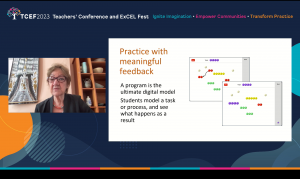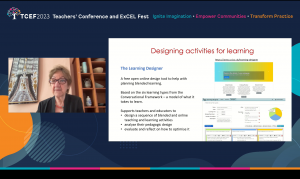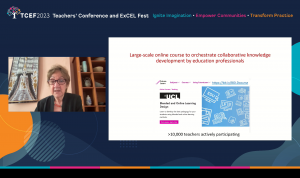Why Singapore’s English Teachers Should Embrace Singlish, Not Fight It
Is it time for Singaporean educators to embrace Singlish as a legitimate learning tool? What the Research […]
Read More
There is no denying that digital technologies have, and will continue to, revolutionize the way we live, work, and learn. Professor Diana Laurillard, Professor of Learning with Digital Technologies from the University College London Institute of Education, United Kingdom, agrees, and opines that with digital technologies becoming a significant part of education, teachers should be given the creative work of designing new digital pedagogies. In her keynote address at the recent Teachers’ Conference and ExCEL Fest 2023, she shares with teacher participants the importance of teachers taking on the role of learning designers who come together to share and test new e-pedagogies. Below is an edited transcript of Professor Laurillard’s keynote address.
Let’s first consider the five different types of active learning – learning through inquiry, discussion, practice, collaboration and production – and the role e-pedagogies play in improving learning.
Learning through inquiry involves exploring contrasting ideas and ways of representing them. The Internet has provided a fantastic opportunity for teachers to explore the different ways of representing a subject matter, for instance, scientific concepts. Images, some of which could be interactive, could transform a teacher’s presentation, or a student’s exploration to improve their understanding.
Learning through discussion usually involves a teacher asking the class to answer certain questions, but how many students normally respond? Perhaps only one or two students will. By using Menti.com, an online platform, every student can now be asked to contribute and respond.
In learning through practice, digital models can be used by students to explore and understand pedagogic concepts. UCL has developed a “number beads” digital game (see Figure 1), which has also been used in a number of primary schools in Singapore. The aim is to help students with low numeracy skills to understand how numbers make up other numbers. The main task for students is to join a string of number beads to make up a whole number. An important feature of this digital game is that it does not inform students that what they have done is right or wrong; instead, a correct combination would earn them a purple star (of which they have to collect 10). It enables them to learn from the game’s feedback. The process tries to capture the students’ natural way of exploring the world. Learning through practice with meaningful feedback is vital for students to be able to understand the fundamental concepts.

Figure 1. Professor Laurillard shares more about the “number beads” digital game developed by UCL.
Learning through collaboration can be done using a Padlet wall. Students can collaborate by sharing and commenting on what they know about a topic while the teachers can use a number of different tools on Padlet.
In learning through production, teachers find out what students have learned and how they can apply that knowledge whether through a worksheet, essay, or diagram. Whatever technologies the teachers use for their own presentation, for example PowerPoint, can also be used by the students as well.
All these are examples in which e-pedagogy supports the different types of active learning. So how can teachers optimize the way they use all these digital methods?
Learning design involves analysing the lesson plan from the learners’ point of view and asking: “What is the learner doing to learn?” Learning design is a way of making pedagogic ideas very explicit. It is important because it enables teachers to innovate by designing activities for learning in some detail, building on the teachers’ knowledge, and then applying them to new pedagogies. The Learning Designer (see Figure 2) is a free online design tool developed to support online learning. It provides a structure for developing a sequence of learning activities to achieve the outcomes teachers have defined. It allows teachers to either adapt an existing learning design or create their own.

Figure 2. Professor Laurillard talks more about the Learning Designer.
How can teachers optimize Learning Designer? One way to do this is to embed the most useful digital tools within it. For example, teachers can set up Google Docs to collect the students’ ideas. To get students to collaborate, they can set up a Miro Board so each group of students can present and share their work. A group forum can be set up on Moodle so that everyone can view each other’s work, discuss and refine their work further.
The teacher’s Learning Designer can be evaluated, either by peers or by the students. For student evaluation, students can be encouraged to comment on the teacher’s learning design. For instance, a student may comment that that they need more time to discuss. It is very important for the teacher to know how the learning design has been experienced by the students.
Teachers can attend courses on massive open online course (MOOC) platforms, such as FutureLearn (see Figure 3). FutureLearn, available at no cost for teachers, focuses on blended and online learning design. The course exercises are based on using the Learning Designer and contributed learning designs from participants are curated for teachers to explore and exchange ideas for good ways of supporting learners.
Teachers can learn how to be involved in the process of contributing, peer reviewing, revising, and then sharing their learning designs. This is how we can gradually build teachers’ collective design knowledge on how to design e-pedagogies.

Figure 3. Professor Laurillard shares more about FutureLearn, an online learning platform that offers courses on blended and online learning design.
So why are e-pedagogies important for teaching and learning? We’ll look at two examples of e-pedagogy learning designs that help teachers to improve their own workload as well as understand how they can benefit students.
Peer learning a significant pedagogy that is very much underrated but works well for students online. In peer learning, the task for each student is to review and give feedback on each other’s work according to the teacher’s rubric, and then use the feedback he/she has received to work on an improved assignment for the teacher to grade. Thus, it does not actually add to the teachers’ actual workload. This form of peer learning can be run entirely online using the school’s virtual learning environment (VLE).
A masterclass is a conventional teaching method for small groups, in which the teacher helps each individual student to get detailed feedback. The process of the teacher giving individual feedback to each of those students is then made vicarious by filming the session, with the student’s consent. The video can then be run on the VLE for other students to view. Even though the students viewing the video receive no personal feedback, they benefit from understanding what the feedback is, how it is given, and may then be able to apply it for their own improvement. Again, the workload for the teacher is just one tutorial whose value is magnified by making the recording available for all students. The method could be repeated for all groups over a term, so that each student has one session of receiving personal feedback. Making use of the VLE in peer reviewing and masterclass sessions can benefit both teachers and students significantly.
There is no doubt that educational technologies have the potential to offer students an active learning experience. But what do teachers need to scaffold that learning experience? Well, teachers need the support to innovate collaboratively, and to share, critique and discuss their ideas. Only then can they apply and improve on those ideas with their students. Another crucial factor is time. Education leaders should ensure that teachers are given the time to do all those things because it is not just about adapting other people’s work, but it is also about being able to develop their own as well.